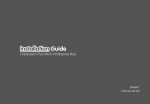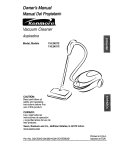Download iogear GCS1102
Transcript
Installation Guide 2/4-Port DVI KVMP Switch with Cables GCS1102/GCS1104 PART NO. M1108/M1109 Table of Contents Package Contents 4 Sun Keyboard Emulation 21 System Requirements 5 Factory Default Hotkeys Settings 22 GCS1102 Overview 6 Firmware Upgrade 23 GCS1104 Overview 8 Upgrade Fail 28 Installation 10 FAQ 29 LED Indications 13 FCC Statements 31 Port Switching 14 CE Statement 33 Hotkeys Summary Table 16 SJ/T 11364-2006 34 Autoscan Mode 17 Limited Warranty 35 Hotkey Setting Mode (HSM) 18 Contact 36 Mac Keyboard Emulation 20 3 Package Contents 1 x 2/4-Port DVI KVMP Switch 2/4 x DVI-D KVM Cables (2 for GCS1102 and 4 for GCS1104) 1 x Power Adapter 1 x Installation Guide 1 x Warranty Card 4 System Requirements Console • DVI-D supported Monitor • USB keyboard and mouse • Powered Speakers and microphone (optional) Computers • A USB port • A DVI-D supported connection • 3.5mm Audio and microphone connections (optional) Operating System • Windows XP • Windows Vista (32-bit/64-bit) • Windows 7 • Mac OS X or greater • Sun Solaris workstation • Linux, UNIX and other USB supported systems* *Additional drivers and support may be needed 5 GCS1102 Overview Front View 1. 2. 3. 4. Port 1 Switch Button Port 2 Switch Button Console USB Keyboard Port Console USB Mouse Port 1 2 6 3 4 Rear View 5. Power Jack 6. USB 2.0 Peripheral Sharing Ports 7. Console Mic. Port 8. Console Audio Port 9. Console DVI Port 10.CPU2 Mic. Port 11.CPU2 Audio Port 5 6 7 12.CPU2 DVI Port 13.CPU2 USB Port 14.CPU1 Mic. Port 15.CPU1 Audio Port 16.CPU1 USB Port 17.CPU1 DVI Port 8 10 11 12 13 9 7 14 15 16 17 GCS1104 Overview Front View 1. 2. 3. 4. Port 1 Switch Button Port 2 Switch Button Port 3 Switch Button Port 4 Switch Button 5. Front Panel Mic. Port 6. Front Panel Audio Port 7. USB 2.0 Peripheral Sharing Port 1 3 2 8 4 5 6 7 Rear View 8. Power Jack 9. Console Mouse Port 10.Console Keyboard Port 11.USB 2.0 Peripheral Sharing Port 12.Console Mic. Port 13.Console Audio Port 14.Console DVI Port 8 9 10 11 12 13 14 15.CPU4 Mic. Port 16.CPU4 Audio Port 17.CPU4 USB Port 18.CPU4 DVI Port 19.CPU3 Mic. Port 20.CPU3 Audio Port 21.CPU3 USB Port 22.CPU3 DVI Port 15 16 17 18 19 20 9 23.CPU2 Mic. Port 24.CPU2 Audio Port 25.CPU2 USB Port 26.CPU2 DVI Port 27.CPU1 Mic. Port 28.CPU1 Audio Port 29.CPU1 USB Port 30.CPU1 DVI Port 21 22 23 24 25 26 27 28 29 30 Installation Step 1 Step 3 Please make sure your computers and monitor are powered off before you start. Connect the DVI cable from your monitor to the console DVI monitor port. Then, turn on your monitor. Step 2 Connect the power adapter from your wall outlet to your power jack of the KVM. 2 3 GCS1104 10 Step 4 Step 5 Connect your USB keyboard and mouse to the console USB keyboard port and console USB mouse port. Connect your powered speaker and mic. to the console audio port and console mic. Port. 4 4 5 5 GCS1104 GCS1102 11 Step 6 Final Step Connect a set of your molded KVM cable from your KVM switch to each of your computers – DVI cable to the DVI output, USB cables to open USB ports from your computer, audio cable to your audio output and mic. cable to the mic. input. Turn on your computers. 12 LED Indications LED Online / Selected USB Link Description Dim Orange A device is powered on and connected to the KVMP switch but the port is not on focus Bright Orange The specific port has focus on the KVM (Keyboard, video and mouse) Green The specific port has focus on the USB peripheral sharing ports 13 Port Switching Port Switching You can switch port via front panel pushbutton or hotkey commands. Port Switching via Front Panel Pushbutton Mode1 (Default) Function Switch All Focus (KVM, Audio and USB) Switch KVM Focus Switch Audio Focus Description Press and hold the specific pushbutton for 2 seconds Press the specific pushbutton once Press the specific pushbutton twice rapidly Mode2* Function Switch All Focus (KVM, Audio and USB) Switch KVM Focus Switch Audio Focus Description Press the specific pushbutton once Press and hold the specific pushbutton for 2 seconds Press the specific pushbutton twice rapidly *Please refer to the HSM (Hotkeys Setting Mode) section for details about how to switch the front panel pushbutton into Mode2. 14 Port Switching via Hotkey Commands To trigger a Hotkey Mode, simply press [Scroll Lock] [Scroll Lock]*. Please refer to Hotkey Summary Table for details. *Note: If there is a conflict using [Scroll Lock] [Scroll Lock] sequence, you can change to the alternative sequence [Ctrl] [Ctrl]. Please refer to Hotkey Setting Mode (HSM) section for details. 15 Hotkeys Summary Table Hotkey combination [Scroll Lock] [Scroll Lock] + or [Ctrl] [Ctrl]* + *Note: If alternative hotkey sequence is chosen Description [Enter] Switch KVM, USB and audio focus to the next port [n*] [Enter] Switch KVM, USB and audio focus to the specific port [k] [Enter] Switch KVM focus to the next port [n*] [k] [Enter] Switch KVM focus to the specific port [u] [Enter] Switch USB focus to the next port [n*] [u] [Enter] Switch USB focus to the specific port [s] [Enter] Switch audio focus to the next port [n*] [s] [Enter] Switch audio focus to the specific port [n*] [k] [s] [Enter] Switch KVM and audio focus to the specific port [n*] [k] [u] [Enter] Switch KVM and USB focus to the specific port [n*] [u] [s] [Enter] Switch USB and audio focus to the specific port *Note: Interval n is the port ID number (1 and 2 for GCS1102 and 1, 2, 3 and 4 for GCS1104) 16 Autoscan Mode You can either activate Autoscan Mode via front panel push button or hotkeys. Function Auto Scan Description Front Panel Push Button Press and hold port 1 and port 2 Pushbutton simultaneously for 2 seconds to activate Autoscan Mode* Hotkeys [Scroll Lock] [Scroll Lock] [a] Activate Autoscan mode. It [Enter] will cycle from port to port every 5 seconds (default) [Scroll Lock] [Scroll Lock] [a] Activate Autoscan mode. It [n] [Enter] will cycle from port to port every n seconds** *Note: Autoscan Mode from front panel push button will be scanning a port every 5 seconds by default. If you wish to have the Autoscan Mode be scanning with different time interval, please trigger Autoscan Mode via hotkeys. **Note: n is an interval between 1 and 99 that stands for the time (in second) desire for scanning each port. 17 Hotkey Setting Mode (HSM) Hotkey 1. Press and hold [Num Lock] ([Clear] key on Mac keyboard) 2. Press and release [-] 3. Release [Num Lock] ([Clear] key on Mac keyboard) Invoke HSM, then press [h] Invoke HSM, then press [t] Invoke HSM, then press [F2] Invoke HSM, then press [F3] Invoke HSM, then press [F10] Invoke HSM, then press [F4] Description Invoking hotkey setting mode Change the HSM invocation keys from [Num Lock] to [Ctrl] and from [-] to [F12] Change port switching hotkey sequence between [Scroll Lock] [Scroll Lock] and [Ctrl] [Ctrl] Enables Mac keyboard emulation Enables Sun keyboard emulation Auto-detect the keyboard operating platform (for PC compatible systems). Activates Pass Through Keyboard Mode (keystrokes are sent directly to the computer instead of through the Mac emulator). List out current settings Note: Please have a Notepad or word document opened before you trigger this function. 18 Invoke HSM, then press [F5] Invoke HSM, then press [b] USB Reset Toggle hotkey beepers on or off Invoke HSM, then press [s] Invoke HSM, then press [x] [Enter] Invoke HSM, then press [u] [p] [g] [r] [a] [d] [e] [Enter] Invoke HSM, then press [r] [Enter] Invoke HSM, then press [d] Invoke HSM, then press [m] Invoke HSM, then press [F1] Toggle front panel pushbutton between Mode1 and Mode2 Disable or enable port switching hotkey Activate Firmware Upgrade Mode – Front panel KVM LED will flash indicating Firmware Upgrade Mode is activated. Restore default settings Capture and store monitor’s EDID on specific port Enable or disable mouse emulation Reset keyboard and mouse under some special OS’ that do not support USB 2.0 *Note: To exit HSM manually, press Esc or spacebar. 19 Mac Keyboard Emulation The PC compatible (101/104 key) keyboard can emulate the functions of the Mac keyboard. The emulation mappings are listed in the table below. PC Keyboard Mac Keyboard [Alt] Alt [Shift] Shift [Print Screen] F13 [Crtl] Ctrl [Scroll Lock] F14 = [Ctrl] [1] [Enter] Return [Ctrl] [2] [Backspace] Delete [Ctrl] [3] [Insert] Help [Ctrl] [4] [Ctrl] F15 *Note: When using key combinations, press and release the first key (Ctrl), then press and release the second key. 20 Sun Keyboard Emulation The PC compatible (101/104 key) keyboard can emulate the functions of the Sun keyboard. The emulation mappings are listed in the table below. PC Keyboard Sun Keyboard [Ctrl] [F9] Find [Crtl] [t] Stop [Crtl] [F10] Cut [Crtl] [F2] Again [Crtl] [1] [Crtl] [F3] Props [Crtl] [2] [Crtl] [F4] Undo [Crtl] [3] [Crtl] [F5] Front [Crtl] [4] [Crtl] [F6] Copy [Crtl] [h] [Crtl] [F7] Open [Crtl] [F8] Paste Help Compose *Note: When using key combinations, press and release the first key (Ctrl), then press and release the second key. 21 Factory Default Hotkeys Settings Function Default Port Switching [Scroll Lock] [Scroll Lock] Invoking HSM [Num Lock] [-] Auto Scan Interval 5 Seconds Beeper On Keyboard Operating Platform Auto Detect Port Switching Keys Enabled Front Panel Pushbutton Mode Mode1 Mouse Emulation On 22 Firmware Upgrade Step 1 Step 3 Please follow through the installation process from the Installation section. Shut down all the other computers that are connected to the KVM. Then Invoke Firmware Upgrade Mode. (Please refer to Hotkeys Setting Mode section) Step 2 Switch ALL focus to the port that you will be using to perform the firmware upgrade. (Please refer to Port Switching Section). Then, go to www.iogear. com to download the latest available firmware or the specific firmware that you wish to use. Step 4 Disconnect your keyboard and mouse from the console keyboard and mouse port, then connect them to the USB peripheral sharing ports. 23 Step 5 Step 6 Windows will now install all the required drivers. You may see the below message popup in tray icon area. After you see the below message “Your new hardware is installed and ready to use.”, extract the downloaded file with WinRAR or compatible software. Then double click on the execute file to begin with the Firmware Upgrade Utility. 24 Step 7 Step 8 Read the License Agreement and click “I Agree” then click “Next” if you wish to continue with the firmware upgrade. Otherwise, click “Cancel” to exit. Choose the correct KVM that you wish to perform firmware upgrade from the “Device List” and then click “Next” to continue. Then the Firmware Upgrade Utility will verify if there is a KVM connected to the computer by the firmware upgrade cable. (Check Firmware Version checkbox is optional) 25 Step 9 Step 10 If you have checked the “Check Firmware Version” checkbox, then the utility will check the current firmware that is on your KVM. If the current firmware is newer than the firmware that you wish to upgrade to, a window will popup and prompt you to ask if you wish to proceed. Simply click “Yes” to start the upgrade and “No” to cancel the upgrade. When the firmware upgrade is done, you will see “Firmware upgrade OK” in the “Status Messages” window. Then simply click “Finish” to complete the whole firmware upgrade process. Note: If you did not check the “Check Firmware Version” checkbox, utility will perform the upgrade automatically no matter what version of firmware you have in the KVM. 26 Final Step Now the KVM will reset by itself and the firmware upgrade process has completed. Then, disconnect the keyboard and mouse from the peripheral sharing ports and connect them back to the console keyboard and mouse port. 27 Upgrade Fail If you didn’t see “Firmware upgrade OK” in the “Status Messages” window, it means that the firmware upgrade has failed. When that happens, please repeat the complete firmware upgrade process. 28 FAQ 1. What is the difference between DVI-A, DVI-D and DVI-I? DVI-A – The “A” stands for analog, which it supports analog DVI signal DVI-D – The “D” stands for digital, which it supports digital DVI signal DVI-I – The “I” stands for intergraded, which it supports both analog and digital DVI signals 2. If you have a DVI monitor with both DVI and VGA computers and you would like to connect them through our GCS1102/GCS1104, what should you do and what do you need to know? a.Please make sure that both monitor and monitor cable are DVI-I supported* b.A VGA Male to Male cable for each of your VGA computer is required** c.A VGA Female to DVI-A Male Adapter for each of your VGA computer is required*** *DVI-I Male to Male Cable (G2LDI006) is available and sold separately at www.iogar.com **VGA Male to Male Cable (G2LVGA006) is available and sold separately at www.iogear.com. ***VGA Female to DVI-A Male Adapter (GDVIMVGAF) is available and sold separately at www.iogear.com. If you meet all the requirements above, then you can follow the below instructions to setup your KVM. Please make sure all devices are turned off before you start. 29 For the DVI computers: Simply follow the instruction of the Installation Section. For the VGA computers: 1. Connect each of your VGA video output with a VGA Male to Male cable. 2. Connect the other side of the VGA cable to the VGA connection on the DVI-A Male to VGA Female Adapter. 3. Connect the DVI-A connection to the CPU DVI port of the KVM. 4. Then use the provided DVI-D KVM cable for USB, audio and mic. connection ONLY. For the Console DVI Port Connect the DVI-I cable from the Console DVI port to the monitor. 30 FCC Statements 15.21 You are cautioned that changes or modifications not expressly approved by the part responsible for compliance could void the user’s authority to operate the equipment. 15.105(b) his equipment has been tested and found to comply with the limits for a Class B digital device, pursuant to part 15 of the FCC rules. These limits are designed to provide reasonable protection against harmful interference in a residential installation. This equipment generates, uses and can radiate radio frequency energy and, if not installed and used in accordance with the instructions, may cause harmful interference to radio communications. However, there is no guarantee that interference will not occur in a particular installation. If this equipment does cause harmful interference to radio or television reception, which can be determined by turning the equipment off and on, the user is encouraged to try to correct the interference by one or more of the following measures: - Reorient or relocate the receiving antenna. - Increase the separation between the equipment and receiver. - Connect the equipment into an outlet on a circuit different from that to which the receiver is connected. - Consult the dealer or an experienced radio/TV technician for help. 31 THIS DEVICE COMPLIES WITH PART 15 OF THE FCC RULES. OPERATION IS SUBJECT TO THE FOLLOWING TWO CONDITIONS: 1. this device may not cause interference and 2. this device must accept any interference, including interference that may cause undesired operation of the device. FCC RF Radiation Exposure Statement: This equipment complies with FCC radiation exposure limits set forth for an uncontrolled environment. End users must follow the specific operating instructions for satisfying RF exposure compliance. This transmitter must not be co-located or operating in conjunction with any other antenna or transmitter. 32 CE Statement This device has been tested and found to comply with the requirements set up in the council directive on the approximation of the law of member states relating to EMC Directive 89/336/EEC, Low Voltage Directive 73/23/EEC and R&TTE Directive 99/5/EC. The product has been approved for LVD and covered the following countries: Belgium, Denmark, France, Germany, Italy, Portugal, U.K., Spain, Sweden 33 SJ/T 11364-2006 The following contains information that relates to China. 有毒有害物质或元素 部件名称 铅 (Pb) 汞 (Hg) 镉(Cd) 六价 (Cr(VI)) 多溴联苯 (PBB) 多溴二苯醚 (PBDE) 电器部件 ● ○ ○ ○ ○ ○ 机构部件 ○ ○ ○ ○ ○ ○ ○:表示该有毒有害物质在该部件所有均质材料中的含量均在SJ/T 11363-2006规定的限量要求之下。 ●:表示符合欧盟的豁免条款,但该有毒有害物质至少在该部件的某一均质材料中的含量超出 SJ/T 11363-2006的限量要求。 ×: 表示该有毒有害物质至少在该部件的某一均质材料中的含量超出SJ/T 11363-2006的限量要求。 34 Limited Warranty IN NO EVENT SHALL THE DIRECT VENDOR’S LIABILITY FOR DIRECT, INDIRECT, SPECIAL, INCIDENTAL OR CONSEQUENTIAL DAMAGES RESULTING FROM THE USE OF THE PRODUCT, DISK, OR ITS DOCUMENTATION EXCEED THE PRICE PAID FOR THE PRODUCT. The direct vendor makes no warranty or representation, expressed, implied, or statutory with respect to the contents or use of this documentation, and especially disclaims its quality, performance, merchantability, or fitness for any particular purpose.The direct vendor also reserves the right to revise or update the device or documentation without obligation to notify any individual or entity of such revisions, or updates. For further inquiries please contact IOGEAR. 35 Contact IOGEAR 23 Hubble Irvine, CA 92618 P 949.453.8782 F 949.453.8785 Visit us at: www.iogear.com 36 About Us FUN IOGEAR offers connectivity solutions that are innovative, fun, and stylish, helping people enjoy daily life using our high technology products. GREEN IOGEAR is an environmentally conscious company that emphasizes the importance of conserving natural resources. The use of our technology solutions helps reduce electronic waste. HEALTH IOGEAR supports healthy and fit lifestyles. By integrating products with the latest scientific developments, IOGEAR’s solutions enhance the life of end-users. © 2009 IOGEAR®


















































